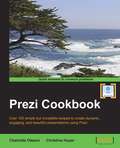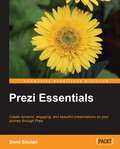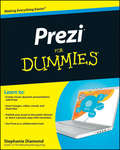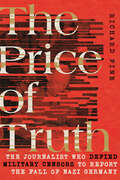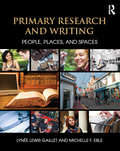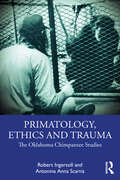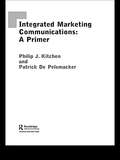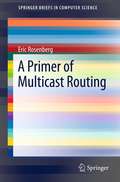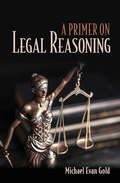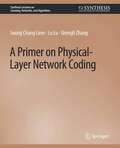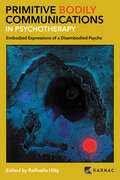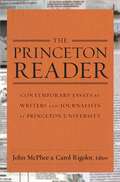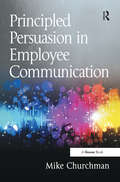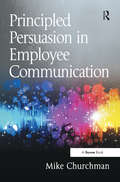- Table View
- List View
Prezi Cookbook
by Charlotte Olsson Christina HoyerThis book is intended for both beginners who want to get started with Prezi as well as experienced users who want to enhance their knowledge of Prezi. If you are a seasoned presenter, you can use this book to quickly transfer your presentation skills to Prezi. If you are new to presenting, the guidelines and tips in this book take you by the hand and guide you to complete mastery of Prezi.
Prezi Essentials
by Domi SinclairIf you want to learn Prezi, and specifically design within Prezi, this is the book for you. Perhaps you already know a bit about Prezi but have never used it, or perhaps you have used Prezi before but want to learn how to incorporate your own custom design elements. In either case, this book will get you up and running quickly. It would be helpful to have a bit of familiarity with basic design concepts and the use of Prezi, but prior experience is not essential.
Prezi For Dummies
by Stephanie DiamondA one-stop resource for an exciting new Web-based, slide-free presentation tool! People who have been seeking a flashier version of PowerPoint have found it—and it's Prezi. A Web-based, slide-free presentation tool, Prezi allows users to create and give rich, Web-based presentations complete with dynamic content, contextual layouts, and eye-catching visuals. Prezi For Dummies gets you rapidly up to speed, including how to think outside the traditional slide, create your project, insert Flash and other graphic files, and publish your presentation to a public domain. You’ll also learn valuable tips on what makes a good Prezi. Introduces Prezi, a Web-based, Flash-friendly, dynamic presentation tool Explains how to use online and offline editors and insert images, video, sound, Flash files, and other complex graphics Covers presenting a Prezi, publishing it to a public domain, and collaborating with others Offers tips and insights on what makes a good Prezi—and how to think visually to create content that benefits your business or organization Move beyond slides, put your visual thinking cap on, and get the very most of Prezi with this timely, practical guide.
Prezi For Dummies
by Stephanie DiamondA one-stop resource for an exciting new Web-based, slide-free presentation tool! People who have been seeking a flashier version of PowerPoint have found it—and it's Prezi. A Web-based, slide-free presentation tool, Prezi allows users to create and give rich, Web-based presentations complete with dynamic content, contextual layouts, and eye-catching visuals. Prezi For Dummies gets you rapidly up to speed, including how to think outside the traditional slide, create your project, insert Flash and other graphic files, and publish your presentation to a public domain. You’ll also learn valuable tips on what makes a good Prezi. Introduces Prezi, a Web-based, Flash-friendly, dynamic presentation tool Explains how to use online and offline editors and insert images, video, sound, Flash files, and other complex graphics Covers presenting a Prezi, publishing it to a public domain, and collaborating with others Offers tips and insights on what makes a good Prezi—and how to think visually to create content that benefits your business or organization Move beyond slides, put your visual thinking cap on, and get the very most of Prezi with this timely, practical guide.
Prezi HOTSHOT
by Hedwyg Van GroenendaalThis book takes a hands-on, tutorial-style approach that walks you through ten individual projects, each focusing on producing a specific Prezi. If you have some basic experience of Prezi and want to gain advanced knowledge by building different kinds of Prezi projects, then this book is for you.
The Price of Truth: The Journalist Who Defied Military Censors to Report the Fall of Nazi Germany
by Richard FineIn The Price of Truth, Richard Fine recounts the intense drama surrounding the German surrender at the end of World War II and the veteran Associated Press journalist Edward Kennedy's controversial scoop. On May 7, 1945, Kennedy bypassed military censorship to be the first to break the news of the Nazi surrender executed in Reims, France. Both the practice and the public perception of wartime reporting would never be the same. While, at the behest of Soviet leaders, Allied authorities prohibited release of the story, Kennedy stuck to his journalistic principles and refused to manage information he believed the world had a right to know. No action by an American correspondent during the war proved more controversial.The Paris press corps was furious at what it took to be Kennedy's unethical betrayal; military authorities threatened court-martial before expelling him from Europe. Kennedy defended himself, insisting the news was being withheld for suspect political reasons unrelated to military security. After prolonged national debate, when the dust settled, Kennedy's career was in ruins. This story of Kennedy's surrender dispatch and the meddling by Allied Command, which was already being called a fiasco in May 1945, revises what we know about media-military relations. Discarding "Good War" nostalgia, Fine challenges the accepted view that relations between the media and the military were amicable during World War II and only later ran off the rails during the Vietnam War. The Price of Truth reveals one of the earliest chapters of tension between reporters committed to informing the public and generals tasked with managing a war.
Pricing, Online Marketing Behavior, and Analytics
by G. VigliaOver the past few decades marketing practices have shifted with the sudden growth of social media and the proliferation of devices, platforms, and applications. This rapidly changing environment presents new opportunities and challenges for marketers, who need to stay up to date with the development of e-marketing. Viglia instructs readers in the theories and practices of online marketing;, detailing the characteristics, consumer behaviors, and differences between platforms, analytics, and pricing strategies of new media. Pricing, Online Marketing Behavior, and Analytics covers many different aspects of how online marketing works and its continuous evolution. Case studies and examples are used throughout the book to outline theories and explain e-marketing characteristics in a practical way.
Primary Research and Writing: People, Places, and Spaces
by Lynee Lewis Gaillet Michelle F. EbleDeveloped for emerging academic writers, Primary Research and Writing offers a fresh take on the nature of doing research in the writing classroom. Encouraging students to write about topics for which they have a passion or personal connection, this text emphasizes the importance of primary research in developing writing skills and abilities. Authors Lynée Lewis Gaillet and Michelle F. Eble have built a pedagogical approach that makes archival and primary research interesting, urgent, and relevant to emerging writers. Students are able to explore ways of analyzing their findings and presenting their results to their intended readers. With in-text features to aid students in understanding primary research and its role in their writing, chapters include special elements such as: Communities in Context – Profiles of traditional and digital communities that help students understand the characteristics of communities and group members Profiles of Primary Researchers – Spotlights on professionals, giving an illuminating look into the role primary research plays in real-world research and writing Student Writing – Examples of exemplary student writing that demonstrate how research can be relevant, engaging, and interesting, with annotations. Invention Exercises - Exercises designed to help students locate primary investigation within communities that they already understand or find appealing Writing Exercises - Writing exercises that offer students practice in exploring communities and investigating primary materials. Readings – Annotated readings with questions to guide analysis, pulled from a variety of rich sources, that give students inspiration for undertaking their own research projects. This text has a robust companion website that provides resources for instructors and students, with sample syllabi, chapter overviews, lecture outlines, sample assignments, and a list of class resources. Primary Research and Writing is an engaging textbook developed for students in the beginning stages of their academic writing careers, and prepares its readers for a lifetime of research and writing.
Primary Research and Writing: People, Places, and Spaces
by Lynee Lewis Gaillet Michelle F. EbleDeveloped for emerging academic writers, Primary Research and Writing offers a fresh take on the nature of doing research in the writing classroom. Encouraging students to write about topics for which they have a passion or personal connection, this text emphasizes the importance of primary research in developing writing skills and abilities. Authors Lynée Lewis Gaillet and Michelle F. Eble have built a pedagogical approach that makes archival and primary research interesting, urgent, and relevant to emerging writers. Students are able to explore ways of analyzing their findings and presenting their results to their intended readers. With in-text features to aid students in understanding primary research and its role in their writing, chapters include special elements such as: Communities in Context – Profiles of traditional and digital communities that help students understand the characteristics of communities and group members Profiles of Primary Researchers – Spotlights on professionals, giving an illuminating look into the role primary research plays in real-world research and writing Student Writing – Examples of exemplary student writing that demonstrate how research can be relevant, engaging, and interesting, with annotations. Invention Exercises - Exercises designed to help students locate primary investigation within communities that they already understand or find appealing Writing Exercises - Writing exercises that offer students practice in exploring communities and investigating primary materials. Readings – Annotated readings with questions to guide analysis, pulled from a variety of rich sources, that give students inspiration for undertaking their own research projects. This text has a robust companion website that provides resources for instructors and students, with sample syllabi, chapter overviews, lecture outlines, sample assignments, and a list of class resources. Primary Research and Writing is an engaging textbook developed for students in the beginning stages of their academic writing careers, and prepares its readers for a lifetime of research and writing.
Primatology, Ethics and Trauma: The Oklahoma Chimpanzee Studies
by Robert Ingersoll Antonina Anna ScarnàPrimatology, Ethics and Trauma offers an analytical re-examination of the research conducted into the linguistic abilities of the Oklahoma chimpanzees, uncovering the historical reality of the research. It has been 50 years since the first language experiments on chimpanzees. Robert Ingersoll was one of the researchers from 1975 to 1983. He is well known for being one of the main carers and best friend of the chimpanzee, Nim Chimpsky, but there were other chimpanzees in the University of Oklahoma's Institute for Primate Studies, including Washoe, Moja, Kelly, Booee, and Onan, who were taught sign language in the quest to discover whether language is learned or innate in humans. Antonina Anna Scarnà’s expertise in language acquisition and neuroscience offers a vehicle for critical evaluation of those studies.Ingersoll and Scarnà investigate how this research failed to address the emotional needs of the animals. Research into trauma has made scientific advances since those studies. It is time to consider the research from a different perspective, examining the neglect and cruelty that was inflicted on those animals in the name of psychological science. This book re-examines those cases, addressing directly the suffering and traumatic experiences endured by the captive chimpanzees, in particular the female chimpanzee, Washoe, and her resultant inability to be a competent mother.The book discusses the unethical nature of the studies in the context of recent research on trauma and offers a specific and direct psychological message, proposing to finally close the door on the language side of these chimpanzee studies. This book is a novel and groundbreaking account. It will be of interest to lay readers and academics alike. Those working as research, experimental, and clinical psychologists will find this book of interest, as will psychotherapists, linguists, anthropologists, historians of science and primatologists, as well as those involved in primate sanctuary and conservation.
Primatology, Ethics and Trauma: The Oklahoma Chimpanzee Studies
by Robert Ingersoll Antonina Anna ScarnàPrimatology, Ethics and Trauma offers an analytical re-examination of the research conducted into the linguistic abilities of the Oklahoma chimpanzees, uncovering the historical reality of the research. It has been 50 years since the first language experiments on chimpanzees. Robert Ingersoll was one of the researchers from 1975 to 1983. He is well known for being one of the main carers and best friend of the chimpanzee, Nim Chimpsky, but there were other chimpanzees in the University of Oklahoma's Institute for Primate Studies, including Washoe, Moja, Kelly, Booee, and Onan, who were taught sign language in the quest to discover whether language is learned or innate in humans. Antonina Anna Scarnà’s expertise in language acquisition and neuroscience offers a vehicle for critical evaluation of those studies.Ingersoll and Scarnà investigate how this research failed to address the emotional needs of the animals. Research into trauma has made scientific advances since those studies. It is time to consider the research from a different perspective, examining the neglect and cruelty that was inflicted on those animals in the name of psychological science. This book re-examines those cases, addressing directly the suffering and traumatic experiences endured by the captive chimpanzees, in particular the female chimpanzee, Washoe, and her resultant inability to be a competent mother.The book discusses the unethical nature of the studies in the context of recent research on trauma and offers a specific and direct psychological message, proposing to finally close the door on the language side of these chimpanzee studies. This book is a novel and groundbreaking account. It will be of interest to lay readers and academics alike. Those working as research, experimental, and clinical psychologists will find this book of interest, as will psychotherapists, linguists, anthropologists, historians of science and primatologists, as well as those involved in primate sanctuary and conservation.
"Prime-Time" für die Wissenschaft?: Wissenschaftsberichterstattung in den Hauptfernsehnachrichten in Deutschland und Frankreich
by Katharina KowalewskiA Primer for Integrated Marketing Communications
by Philip Kitchen Patrick De PelsmackerThis textbook is the first introductory primer on integrated marketing communications. It combines theory and practice to show students of marketing how different aspects of integrated marketing communications (IMC) work together. Setting the scene in which IMC has emerged, the authors explain each component of the promotional mix and go on to explain the process of functional integration. The text includes key case studies on companies, including Proctor and Gamble, NSPCC and Ardi, illustrating the practical side of IMC in addition to an introduction to the main theories at work. Including an additional Study Guide at the back, this book will be a valuable resource for students of marketing and marketing communications.
A Primer for Integrated Marketing Communications
by Philip Kitchen Patrick De PelsmackerThis textbook is the first introductory primer on integrated marketing communications. It combines theory and practice to show students of marketing how different aspects of integrated marketing communications (IMC) work together. Setting the scene in which IMC has emerged, the authors explain each component of the promotional mix and go on to explain the process of functional integration. The text includes key case studies on companies, including Proctor and Gamble, NSPCC and Ardi, illustrating the practical side of IMC in addition to an introduction to the main theories at work. Including an additional Study Guide at the back, this book will be a valuable resource for students of marketing and marketing communications.
A Primer of Multicast Routing (SpringerBriefs in Computer Science)
by Eric RosenbergWhereas unicast routing determines a path from one source node to one destination node, multicast routing determines a path from one source to many destinations, or from many sources to many destinations. We survey multicast routing methods for when the set of destinations is static, and for when it is dynamic. While most of the methods we review are tree based, some non-tree methods are also discussed. We survey results on the shape of multicast trees, delay constrained multicast routing, aggregation of multicast traffic, inter-domain multicast, and multicast virtual private networks. We focus on basic algorithmic principles, and mathematical models, rather than implementation level protocol details. Many historically important methods, even if not currently used, are reviewed to give perspective on the evolution of multicast routing.
Primer on Client-Side Web Security (SpringerBriefs in Computer Science)
by Philippe De Ryck Lieven Desmet Frank Piessens Martin JohnsThis volume illustrates the continuous arms race between attackers and defenders of the Web ecosystem by discussing a wide variety of attacks. In the first part of the book, the foundation of the Web ecosystem is briefly recapped and discussed. Based on this model, the assets of the Web ecosystem are identified, and the set of capabilities an attacker may have are enumerated. In the second part, an overview of the web security vulnerability landscape is constructed. Included are selections of the most representative attack techniques reported in great detail. In addition to descriptions of the most common mitigation techniques, this primer also surveys the research and standardization activities related to each of the attack techniques, and gives insights into the prevalence of those very attacks. Moreover, the book provides practitioners a set of best practices to gradually improve the security of their web-enabled services. Primer on Client-Side Web Security expresses insights into the future of web application security. It points out the challenges of securing the Web platform, opportunities for future research, and trends toward improving Web security.
A Primer on Legal Reasoning
by Michael Evan GoldAfter years of teaching law courses to undergraduate, graduate, and law students, Michael Evan Gold has come to believe that the traditional way of teaching – analysis, explanation, and example – is superior to the Socratic Method for students at the outset of their studies.In courses taught Socratically, even the most gifted students can struggle, and many others are lost in a fog for months. Gold offers a meta approach to teaching legal reasoning, bringing the process of argumentation to the fore.Using examples both from the law and from daily life, Gold's book will help undergraduates and first-year law students to understand legal discourse. The book analyzes and illustrates the principles of legal reasoning, such as logical deduction, analogies and distinctions, and application of law to fact, and even solves the mystery of how to spot an issue.In Gold's experience, students who understand the principles of analytical thinking are able to understand arguments, to evaluate and reply to them, and ultimately to construct sound arguments of their own.
A Primer on Physical-Layer Network Coding (Synthesis Lectures on Learning, Networks, and Algorithms)
by Soung Liew Lu Lu Shengli ZhangThe concept of physical-layer network coding (PNC) was proposed in 2006 for application in wireless networks. Since then it has developed into a subfield of communications and networking with a wide following. This book is a primer on PNC. It is the outcome of a set of lecture notes for a course for beginning graduate students at The Chinese University of Hong Kong. The target audience is expected to have some prior background knowledge in communication theory and wireless communications, but not working knowledge at the research level. Indeed, a goal of this book/course is to allow the reader to gain a deeper appreciation of the various nuances of wireless communications and networking by focusing on problems arising from the study of PNC. Specifically, we introduce the tools and techniques needed to solve problems in PNC, and many of these tools and techniques are drawn from the more general disciplines of signal processing, communications, and networking: PNC is used as a pivot to learn about the fundamentals of signal processing techniques and wireless communications in general. We feel that such a problem-centric approach will give the reader a more in-depth understanding of these disciplines and allow him/her to see first-hand how the techniques of these disciplines can be applied to solve real research problems. As a primer, this book does not cover many advanced materials related to PNC. PNC is an active research field and many new results will no doubt be forthcoming in the near future. We believe that this book will provide a good contextual framework for the interpretation of these advanced results should the reader decide to probe further into the field of PNC.
Primitive Bodily Communications in Psychotherapy: Embodied Expressions of a Disembodied Psyche
by Raffaella HiltyEvery psychotherapist will be familiar with what it means to experience the hatred and despair of their most vulnerable patients in the midst of a psychotherapy session. Most often these patients will manage to express their feelings verbally, but what about those who never developed the capacity to speak? Or those who are capable of talking, but carry a complex range of unprocessed embodied feelings that cannot be verbally expressed? Some patients must rely on another type of language in order to communicate their dissociative states of mind. Primitive Bodily Communications explores how the ‘talking cure’ can still work when words fail and the body ‘talks.’ Non-verbal communication can be thought of as a form of body language and, even though this is a topic not frequently discussed, many practitioners have experienced working with people who communicate through the use of their bodies. The book does not refer to bodily communications as primitive because we see them as inferior to verbal language, but simply because they point to the beginnings of psychological development, to primary ways of being and relating, as well as to enduring aspects of ourselves. The contributors explore the topic of primitive bodily communications in the context of intellectual disability, eating disorders and bodily neglect, focusing on the communicative aspect of bodily expressions within the therapeutic relationship. A wide spectrum of clinical cases illustrates how these patients can reach a state of better physical and emotional containment and, when possible, of verbal communication.
The Princeton Reader: Contemporary Essays by Writers and Journalists at Princeton University
by John McPhee & Carol RigolotFrom a Swedish hotel made of ice to the enigma of UFOs, from a tragedy on Lake Minnetonka to the gold mine of cyberpornography, The Princeton Reader brings together more than 90 favorite essays by 75 distinguished writers. This collection of nonfiction pieces by journalists who have held the Ferris/McGraw/Robbins professorships at Princeton University offers a feast of ideas, emotions, and experiences--political and personal, light-hearted and comic, serious and controversial--for anyone to dip into, contemplate, and enjoy.The volume includes a plethora of topics from the environment, terrorism, education, sports, politics, and music to profiles of memorable figures and riveting stories of survival. These important essays reflect the high-quality work found in today's major newspapers, magazines, broadcast media, and websites. The book's contributors include such outstanding writers as Ken Armstrong of the Seattle Times; Jill Abramson, Jim Dwyer, and Walt Bogdanich of the New York Times; Evan Thomas of Newsweek; Joel Achenbach and Marc Fisher of the Washington Post; Nancy Gibbs of Time; and Jane Mayer, John McPhee, John Seabrook, and Alex Ross of the New Yorker.The perfect collection for anyone who enjoys compelling narratives, The Princeton Reader contains a depth and breadth of nonfiction that will inspire, provoke, and endure.
The Princeton Reader: Contemporary Essays by Writers and Journalists at Princeton University
by John McPhee Carol RigolotFrom a Swedish hotel made of ice to the enigma of UFOs, from a tragedy on Lake Minnetonka to the gold mine of cyberpornography, The Princeton Reader brings together more than 90 favorite essays by 75 distinguished writers. This collection of nonfiction pieces by journalists who have held the Ferris/McGraw/Robbins professorships at Princeton University offers a feast of ideas, emotions, and experiences--political and personal, light-hearted and comic, serious and controversial--for anyone to dip into, contemplate, and enjoy.The volume includes a plethora of topics from the environment, terrorism, education, sports, politics, and music to profiles of memorable figures and riveting stories of survival. These important essays reflect the high-quality work found in today's major newspapers, magazines, broadcast media, and websites. The book's contributors include such outstanding writers as Ken Armstrong of the Seattle Times; Jill Abramson, Jim Dwyer, and Walt Bogdanich of the New York Times; Evan Thomas of Newsweek; Joel Achenbach and Marc Fisher of the Washington Post; Nancy Gibbs of Time; and Jane Mayer, John McPhee, John Seabrook, and Alex Ross of the New Yorker.The perfect collection for anyone who enjoys compelling narratives, The Princeton Reader contains a depth and breadth of nonfiction that will inspire, provoke, and endure.
Principled Persuasion in Employee Communication
by Mike ChurchmanPrincipled Persuasion in Employee Communication highlights a new but significant dilemma for organisational leaders. Will they continue on the same track that, since the nineteenth century, has led them to exert increasing control over their employees? Or will they take another path, one that leads towards a new type of working environment where the culture encourages freedom of communication and movement? This book argues for an approach to employee communication that sets out to liberate employees from the stifling constraints that organisations continue to impose on them. Principled Persuasion is so-called because it uses persuasive techniques, based on clear principles, to create new, forward-looking organisational cultures. It sets out to increase employee happiness and minimise the harms done to employees at work. It grounds itself on a strong ethical base composed of fundamental, universal principles. It introduces a new approach to the use of language, not only calling for more clarity and meaning in organisational communication, but also for a more conscious use of rhetorical techniques to change vocabulary, metaphors and internal dialogue for the better. Make no mistake, most organisations have totally underrated the strategic importance of employee communication. Principled Persuaders understand that the key to dealing with the unpredictable events about to unfold in the twenty-first century will be a new way of communicating with the workforce. The flexibility, adaptability and innovation that will be needed to survive and prosper in coming decades can only be achieved by liberating employees, not imprisoning them further in established systems and processes.
Principled Persuasion in Employee Communication
by Mike ChurchmanPrincipled Persuasion in Employee Communication highlights a new but significant dilemma for organisational leaders. Will they continue on the same track that, since the nineteenth century, has led them to exert increasing control over their employees? Or will they take another path, one that leads towards a new type of working environment where the culture encourages freedom of communication and movement? This book argues for an approach to employee communication that sets out to liberate employees from the stifling constraints that organisations continue to impose on them. Principled Persuasion is so-called because it uses persuasive techniques, based on clear principles, to create new, forward-looking organisational cultures. It sets out to increase employee happiness and minimise the harms done to employees at work. It grounds itself on a strong ethical base composed of fundamental, universal principles. It introduces a new approach to the use of language, not only calling for more clarity and meaning in organisational communication, but also for a more conscious use of rhetorical techniques to change vocabulary, metaphors and internal dialogue for the better. Make no mistake, most organisations have totally underrated the strategic importance of employee communication. Principled Persuaders understand that the key to dealing with the unpredictable events about to unfold in the twenty-first century will be a new way of communicating with the workforce. The flexibility, adaptability and innovation that will be needed to survive and prosper in coming decades can only be achieved by liberating employees, not imprisoning them further in established systems and processes.
Principled Persuasion in Employee Communication
by Mike ChurchmanPrincipled Persuasion in Employee Communication highlights a new but significant dilemma for organisational leaders. Will they continue on the same track that, since the nineteenth century, has led them to exert increasing control over their employees? Or will they take another path, one that leads towards a new type of working environment where the culture encourages freedom of communication and movement? This book argues for an approach to employee communication that sets out to liberate employees from the stifling constraints that organisations continue to impose on them. Principled Persuasion is so-called because it uses persuasive techniques, based on clear principles, to create new, forward-looking organisational cultures. It sets out to increase employee happiness and minimise the harms done to employees at work. It grounds itself on a strong ethical base composed of fundamental, universal principles. It introduces a new approach to the use of language, not only calling for more clarity and meaning in organisational communication, but also for a more conscious use of rhetorical techniques to change vocabulary, metaphors and internal dialogue for the better. Make no mistake, most organisations have totally underrated the strategic importance of employee communication. Principled Persuaders understand that the key to dealing with the unpredictable events about to unfold in the twenty-first century will be a new way of communicating with the workforce. The flexibility, adaptability and innovation that will be needed to survive and prosper in coming decades can only be achieved by liberating employees, not imprisoning them further in established systems and processes.
Principled Persuasion in Employee Communication (PDF)
by Mike ChurchmanPrincipled Persuasion in Employee Communication highlights a new but significant dilemma for organisational leaders. Will they continue on the same track that, since the nineteenth century, has led them to exert increasing control over their employees? Or will they take another path, one that leads towards a new type of working environment where the culture encourages freedom of communication and movement? This book argues for an approach to employee communication that sets out to liberate employees from the stifling constraints that organisations continue to impose on them. Principled Persuasion is so-called because it uses persuasive techniques, based on clear principles, to create new, forward-looking organisational cultures. It sets out to increase employee happiness and minimise the harms done to employees at work. It grounds itself on a strong ethical base composed of fundamental, universal principles. It introduces a new approach to the use of language, not only calling for more clarity and meaning in organisational communication, but also for a more conscious use of rhetorical techniques to change vocabulary, metaphors and internal dialogue for the better. Make no mistake, most organisations have totally underrated the strategic importance of employee communication. Principled Persuaders understand that the key to dealing with the unpredictable events about to unfold in the twenty-first century will be a new way of communicating with the workforce. The flexibility, adaptability and innovation that will be needed to survive and prosper in coming decades can only be achieved by liberating employees, not imprisoning them further in established systems and processes.
